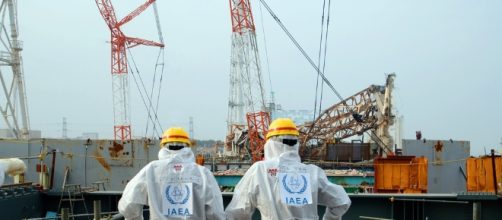Just after 2:45 PM on March 11, 2011, a 9.0-magnitude earthquake struck the eastern coast of Japan. The earthquake – the fourth most powerful everrecorded – was accompanied by a series of tsunami waves that spread throughout the Pacific Ocean, some reaching heights of 30 feet or greater. Off the coast of Fukushima Prefecture, several such waves overtook the Fukushima Daiichi nuclear power plant, flooding the reactors’ cooling systems and disabling the emergency generators. In the hours that followed, the reactors of the plant went into nuclear meltdown, releasing massive amounts of radioactive material into the environment.
The event was later classified as the second largest nuclear disaster in history, following the Chernobyl disaster of 1986.
A retrospective.
A paper recently presented by the Scientific Committee on Oceanic Research (SCOR) Working Group at the Goldschmidt Conference in Japan (and to be published in the Annual Review of Marine Science later this year) reviewed the findings of over 20 geochemical studies conducted overthe past five years pertaining to the effects of Fukushima radiation on ocean chemistry, marine ecosystems, and human health. The SCOR Working Group, led by Dr. Ken Buesseler of the Woods Hole Oceanographic Institution, is comprised of ten scientists hailing from nine countries.
In an article for PBS NewsHour published this past March, Buesseler emphasized the unprecedented dangers that Fukushima’s fallout posed to marine life: “More than eighty percent of the radioactivity from the damaged reactors [at Fukushima] ended up in the Pacific,” he said, “far more than reached the ocean from Chernobylor Three Mile Island.”
Radiation in marine ecosystems.
The reportdelves more deeply into Buesseler’s statement, exploring the links not only between nuclear radiation and ocean ecosystems, but between radiation and human health as well. Humans can be exposed to radiation through direct contact, inhalation, and ingestion of contaminated food. Several studies covered in the review found that the water-soluble radioactive elements released during the disaster had accumulated in the fatty tissues of fish living in Fukushima Bay, a hotspot of the seafood industry.
The majority of aquatic species studied throughout the year-long period following the disaster displayed levels of radioactive cesium approximately ten times Japan’s regulatory limit for seafood, with a handful of others boasting levels several thousand times the limit. Lower, but nonetheless significant, radioactivity levels were also measured in fish and seaweed species living along the Pacific coasts of the United States and Canada. More recent research has found that while radioactivity levels in fish have decreased considerably, they still remain above pre-Fukushima levels.
Ties to cancer.
While the amounts of radioactivity present in these marine organisms may be relatively low, consumption over a long period of time has the potential to increase an individual’s risk of developing cancer.
So far, no human deaths have been recorded as a direct result of radiation exposure, whether through contact, inhalation, or ingestion – however, it must be noted that such effects can take decades to manifest. Studies done on Hiroshimasurvivors, for example, revealed that most cases of cancer attributable to radiation emerged approximately 10 years after the bombing.
Looking to the future.
SCOR believes that the physiological effects of exposure from Fukushima have yet to fully emerge, and that the survivors who were youngest at the time of the accident will most likely be affected to the greatest degree. Of course, these predictions are just that – predictions. Only time will tell how much of an impact the 2011 Fukushima disaster will have on human health.
An advance version of the review, “Fukushima Daiichi-Derived Radionuclides in the Ocean: Transport, Fate, and Impacts,” can be accessed via theAnnual Review of Marine Science database.

